
|
It approached to the sun down to 0.73 A.U. on Mar. 24, and brightened up to 4.7 mag (Mar. 11, Michael Mattiazzo). Now it is fading. But it is still bright as 9.6 mag (July 13, D. Sidorko). In the Northern Hemisphere, it keeps observable in good condition while fading gradually. In the Southern Hemisphere, it will never be observable again.
Date(TT) R.A. (2000) Decl. Delta r Elong. m1 Best Time(A, h)
July 13 23 26.84 62 29.3 1.895 2.048 83 8.9 4:04 (180, -7)
July 20 22 59.98 65 52.3 1.943 2.142 86 9.1 3:10 (180,-11)
|

|
The condition is worst and the comet will be hardly observable in this apparition. In the Northern Hemisphere, it will be observable in autumn when the comet will be fainter than 16 mag.
Date(TT) R.A. (2000) Decl. Delta r Elong. m1 Best Time(A, h)
July 13 6 27.91 23 20.6 2.009 1.053 14 10.2 5:36 (246, -7)
July 20 6 59.91 23 39.6 2.022 1.062 13 10.1 5:34 (247, -8)
|
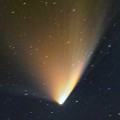
|
It passed the perihelion on Mar. 10, and brightened up to 0-1 mag. Now it is fading. But it is still bright as 10.9 mag (July 10, D. Sidorko). It is observable in good condition in the Northern Hemisphere. It will be observable in the extremely low sky from mid August to mid September also in the Southern Hemisphere.
Date(TT) R.A. (2000) Decl. Delta r Elong. m1 Best Time(A, h)
July 13 14 31.47 60 26.1 2.477 2.482 78 10.9 19:06 (180, -5)
July 20 14 34.09 56 56.6 2.602 2.582 77 11.2 18:41 (180, -2)
|

|
Brightening very rapidly near the perihelion as predicted. Now it is 13.3 mag and already visible visually (July 8, Chris Wyatt). It is expected to reach up to 12 mag in the evening sky from July to August.
Date(TT) R.A. (2000) Decl. Delta r Elong. m1 Best Time(A, h)
July 13 11 22.81 7 41.1 1.209 1.090 57 12.5 18:34 (132, 34)
July 20 11 53.62 7 14.8 1.210 1.102 58 12.1 18:38 (131, 34)
|
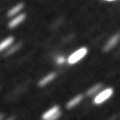
|
It brightened up to 14.4 mag until April (Apr. 13, Sandor Szabo). It will brighten up to 12 mag from summer to autumn. Now it is not observable. In the Southern Hemisphere, it will become observable in August, then it keeps observable while fading gradually. It will never be observable again in the Northern Hemisphere.
Date(TT) R.A. (2000) Decl. Delta r Elong. m1 Best Time(A, h)
July 13 6 25.45 17 8.1 2.489 1.535 15 12.8 5:36 (251, -3)
July 20 6 41.81 14 0.5 2.429 1.506 19 12.7 5:34 (252, 1)
|
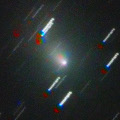
|
Now it is so bright as 11.2 mag (July 3, Con Stoitsis). In the Southern Hemisphere, it keeps observable for a long time until the comet fades out, although it keeps locating low. It will never be observable again in the Northern Hemisphere.
Date(TT) R.A. (2000) Decl. Delta r Elong. m1 Best Time(A, h)
July 13 7 34.52 -19 48.2 2.376 1.753 41 12.8 18:34 ( 70, 7)
July 20 7 51.60 -23 0.3 2.394 1.802 43 13.0 5:34 (293, 8)
|

|
New bright comet discovered in the extremely low sky at dawn. Now it is 12.9 mag (July 12, Hidetaka Sato). It keeps 12-13 mag until autumn, but it keeps locating extremely low in the morning sky. It is not observable until November in the Southern Hemisphere.
Date(TT) R.A. (2000) Decl. Delta r Elong. m1 Best Time(A, h)
July 13 5 57.71 45 8.5 2.143 1.359 29 13.0 5:36 (225,-15)
July 20 6 34.69 43 49.5 2.113 1.317 28 12.8 5:34 (227,-16)
|

|
It is expected to be a great comet in 2013 autumn when the comet approaches to the sun down to only 0.01 A.U. It keeps visible with naked eyes from November to January, and can be extremely bright as Venus or more at the highlight. However, the brightening has declined at 15.5 mag from January through May in 2013. Now it is not observable. The condition is excellent in the Northern Hemisphere. It will appear in the morning sky again in late August, then it keeps observable almost all through the period of brightening, at the highlight, and of fading. The condition is not good in the Southern Hemisphere. It is not observable at all the latter part of the highlight, and it keeps low all through the period.
Date(TT) R.A. (2000) Decl. Delta r Elong. m1 Best Time(A, h)
July 13 7 38.09 26 10.7 3.949 2.937 4 13.2 18:34 (109,-19)
July 20 7 45.86 25 44.9 3.846 2.837 5 13.0 5:34 (251,-18)
|

|
It brightened up to 12 mag in 2012. It is bright as 13.3 mag still now (July 1, Hidetaka Sato). It keeps 13-14 mag until autumn. It locates somewhat low in the Northern Hemisphere.
Date(TT) R.A. (2000) Decl. Delta r Elong. m1 Best Time(A, h)
July 13 19 38.55 -34 36.0 2.012 3.012 167 13.0 0:17 (180, 90)
July 20 19 33.01 -35 14.0 2.031 3.023 164 13.0 23:39 ( 0, 90)
|
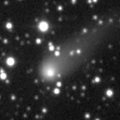
|
Now it is 13.1 mag (July 13, D. Sidorko). It keeps bright at 13-14 mag for a long time until 2014. It keeps observable for a long time in the Northern Hemisphere. It locates somewhat low in the Southern Hemisphere.
Date(TT) R.A. (2000) Decl. Delta r Elong. m1 Best Time(A, h)
July 13 20 27.09 32 12.7 5.281 5.912 124 13.2 1:05 (180, 23)
July 20 20 19.21 31 33.9 5.242 5.915 127 13.2 0:29 (180, 23)
|

|
It brightened up to 11-12 mag in 2012. Now it is bright as 13.3 mag (June 11, Sandor Szabo). It keeps observable in good condition until July in the Northern Hemisphere, or until September in the Southern Hemisphere.
Date(TT) R.A. (2000) Decl. Delta r Elong. m1 Best Time(A, h)
July 13 13 14.64 -10 1.7 6.057 6.149 90 13.3 18:34 (155, 63)
July 20 13 12.78 -9 56.8 6.213 6.177 83 13.4 18:38 (140, 59)
|

|
Now it is 12.2 mag and visible visually (July 3, Con Stoitsis).
Date(TT) R.A. (2000) Decl. Delta r Elong. m1 Best Time(A, h)
July 13 13 36.74 -20 32.6 5.963 6.207 99 13.8 18:34 (159, 75)
July 20 13 38.31 -20 30.2 6.070 6.205 92 13.9 18:38 (138, 72)
|

|
Now it is 14.5 mag (June 11, Sandor Szabo). It keeps 13 mag and observable in good condition in the Northern Hemisphere for a long time from 2013 to 2014. But it locates low in July and August. In the Southern Hemisphere, it is not observable until 2014 autumn.
Date(TT) R.A. (2000) Decl. Delta r Elong. m1 Best Time(A, h)
July 13 9 16.10 50 37.2 4.545 3.764 35 14.0 18:34 (141,-16)
July 20 9 21.05 50 50.7 4.534 3.739 34 14.0 18:38 (139,-19)
|

|
Big asteroid discovered in 1906. It suddenly showed the cometary activity on Dec. 11, 2010, probably due to an impact of a small object. It has already turned to be stellar.
Date(TT) R.A. (2000) Decl. Delta r Elong. m1 Best Time(A, h)
July 13 0 58.50 -11 54.7 2.571 2.946 101 14.3 5:35 (180, 67)
July 20 1 1.90 -12 7.9 2.495 2.957 107 14.2 5:11 (180, 67)
|
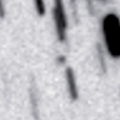
|
Now it is 15.5 mag (July 8, Sandor Szabo). It is expected to brighten up to 14 mag in July and August. In the Southern Hemisphere, it keeps observable for a long time until the comet fades out. It keeps observable in good condition until September also in the Northern Hemisphere.
Date(TT) R.A. (2000) Decl. Delta r Elong. m1 Best Time(A, h)
July 13 21 0.76 7 10.8 1.480 2.374 143 14.6 1:39 (180, 48)
July 20 20 40.84 2 28.1 1.399 2.357 154 14.5 0:52 (180, 52)
|
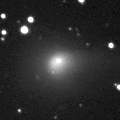
|
Now it is bright as 13.5 mag (June 12, Sandor Szabo). It keeps locating in the morning sky for a long time after this. I will keep the current brightness for a long time.
Date(TT) R.A. (2000) Decl. Delta r Elong. m1 Best Time(A, h)
July 13 1 10.89 11 46.1 1.992 2.233 89 14.5 5:36 (184, 43)
July 20 1 16.13 11 25.2 1.972 2.302 95 14.6 5:25 (180, 43)
|
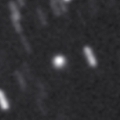
|
Now it is 14.3 mag and visible visually (July 8, Gabor Santa and Krisztian Sarneczky). It is expected to brighten up to 5-6 mag in 2014 autumn. In 2013, it keeps observable in good condition until autumn when it brigthens up to 13-14 mag.
Date(TT) R.A. (2000) Decl. Delta r Elong. m1 Best Time(A, h)
July 13 16 2.65 21 9.9 4.735 5.228 113 14.6 20:36 (180, 34)
July 20 15 56.80 20 45.0 4.755 5.161 108 14.5 20:03 (180, 34)
|
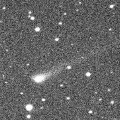
|
Now it is 14.3 mag (July 8, Chris Wyatt). It keeps bright as 13-14 mag for a long time from 2013 to 2014.
Date(TT) R.A. (2000) Decl. Delta r Elong. m1 Best Time(A, h)
July 13 14 8.03 -11 32.5 2.914 3.298 103 14.7 18:43 (180, 67)
July 20 14 10.91 -12 3.3 2.997 3.286 97 14.7 18:38 (168, 67)
|
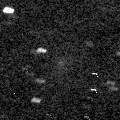
|
Now it is 16.9 mag (June 9, Hidetaka Sato). It will approach to the Sun down to 0.9 A.U., and to the Earth down to 0.4 A.U. in September. So it was expected to brighten up to 11-12 mag. However, it looks extremely diffuse on July 12 by Michael Jager. So the comet can be already disintegrated. In the Northern Hemisphere, it keeps observable in good condition until mid September. In the Southern Hemisphre, it will getting higher after August, and it keeps observable in good condition after that.
Date(TT) R.A. (2000) Decl. Delta r Elong. m1 Best Time(A, h)
July 13 13 36.47 45 16.8 1.055 1.274 75 15.2 18:34 (176, 10)
July 20 13 43.23 42 43.1 0.983 1.198 73 14.7 18:38 (171, 12)
|
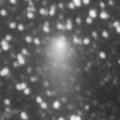
|
It kept bright as 11-13 mag for a long time from 2012 summer to 2013 summer. It will be fading after this. Now it is 14.8 mag (July 8, Sandor Szabo). In the Northern Hemisphere, it keeps observable for a long time until the comet fades out. In the Southern Hemisphere, it becomes low in late August, then it will be hardly observable.
Date(TT) R.A. (2000) Decl. Delta r Elong. m1 Best Time(A, h)
July 13 13 16.46 21 1.7 3.680 3.636 79 14.9 18:34 (168, 33)
July 20 13 16.96 21 1.9 3.847 3.694 73 15.1 18:38 (160, 31)
|

|
Few observations have been reported recently. It keeps 15 mag in 2013. It is observable in good condition in the Southern Hemisphere. It will be observable in good condition also in the Northern Hemisphere after August.
Date(TT) R.A. (2000) Decl. Delta r Elong. m1 Best Time(A, h)
July 13 4 5.52 -23 30.1 7.116 6.786 67 15.2 5:36 (267, 48)
July 20 4 7.74 -23 29.2 7.073 6.815 71 15.2 5:34 (263, 53)
|

|
Now it is 14.0 mag and visible visually (June 11, Sandor Szabo). It reaches up to 14-15 mag from spring to summer. It is observable in excellent condition in the Southern Hemisphere. It locates low in the Northern Hemisphere.
Date(TT) R.A. (2000) Decl. Delta r Elong. m1 Best Time(A, h)
July 13 12 48.55 -12 29.9 3.314 3.389 85 15.6 18:34 (140, 62)
July 20 12 48.12 -11 0.4 3.459 3.399 78 15.7 18:38 (129, 57)
|
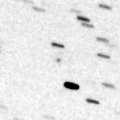
|
It brightened very rapidly. Now it is so bright as 14.0 mag (July 1, Hidetaka Sato). It keeps observable in good condition for a while in the Southern Hemipshere. It will never be observable again in the Northern Hemisphere.
Date(TT) R.A. (2000) Decl. Delta r Elong. m1 Best Time(A, h)
July 13 11 11.18 -19 28.1 2.201 2.054 68 15.7 18:34 (101, 50)
July 20 11 6.57 -19 56.8 2.327 2.049 61 15.8 18:38 ( 94, 43)
|

|
First return of a new periodic comet discovered in 1998. It brightened up to 10 mag at the discovery. Now it is 17.5 mag (July 12, K. Sarneczky, G. Marschalko). In the Northern Hemisphere, it keeps observable in excellent condition from autumn to spring. It locates somewhat low in the Southern Hemisphere.
Date(TT) R.A. (2000) Decl. Delta r Elong. m1 Best Time(A, h)
July 13 3 55.71 36 2.3 3.636 3.053 48 15.9 5:36 (215, 8)
July 20 4 7.99 36 41.7 3.531 3.013 51 15.7 5:34 (212, 9)
|

|
It brightened up to 9.0 mag in 2012 autumn (Nov. 4, Juan Jose Gonzalez). However, it faded out unexpectedly around the perihelion passage. Now it is fainter than originally predicted by 4-5 mag. Now it is 15.2 mag (June 3, Hidetaka Sato). In the Southern Hemisphere, it keeps observable in good condition while fading slowly after this. In the Northern Hemisphere, it will not be observable after this.
Date(TT) R.A. (2000) Decl. Delta r Elong. m1 Best Time(A, h)
July 13 3 31.06 -43 52.7 2.797 2.897 85 15.8 5:36 (299, 60)
July 20 3 40.15 -44 29.7 2.821 2.959 87 15.9 5:34 (300, 63)
|
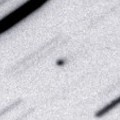
|
Now it is 16.3 mag (June 18, Catalina Sky Survey). It brightens up to 15.5 mag and will be observable in excellent condition from summer to autumn.
Date(TT) R.A. (2000) Decl. Delta r Elong. m1 Best Time(A, h)
July 13 21 39.71 -3 47.9 1.280 2.183 143 15.9 2:17 (180, 59)
July 20 21 37.81 -2 21.6 1.235 2.172 149 15.8 1:48 (180, 57)
|

|
Not observed yet in this apparition. It will brighten very rapidly near the perihelion passage. It is expected to reach up to 10 mag from autumn to winter. But actually, it is not detected, fainter than 20.5 mag on July 6 (Hidetaka Sato). In the Northern Hemipshere, it keeps observable in excellent condition until the comet fades out. In the Southern Hemisphere, it keeps observable in good condition within 2013, but it will not be observable in 2014.
Date(TT) R.A. (2000) Decl. Delta r Elong. m1 Best Time(A, h)
July 13 23 1.74 -18 43.3 1.476 2.270 130 16.3 3:39 (180, 74)
July 20 23 2.72 -18 9.5 1.374 2.223 136 16.0 3:12 (180, 73)
|
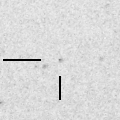
|
Few observations have been reported recently. It keeps observable in good condition at 17 mag from spring to summer.
Date(TT) R.A. (2000) Decl. Delta r Elong. m1 Best Time(A, h)
July 13 18 30.29 -5 2.3 2.013 2.980 157 16.4 23:04 (180, 60)
July 20 18 27.05 -5 0.1 2.051 2.992 153 16.5 22:33 (180, 60)
|
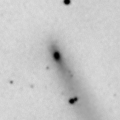
|
Now it is 16.1 mag (June 30, Hiroshi Abe). It will be observable at 14-16 mag for a long time from 2013 to 2014.
Date(TT) R.A. (2000) Decl. Delta r Elong. m1 Best Time(A, h)
July 13 12 12.33 1 17.1 4.020 3.826 71 16.5 18:34 (140, 46)
July 20 12 17.87 0 29.2 4.112 3.825 66 16.6 18:38 (132, 43)
|

|
Now it is 17.1 mag (June 8, Ken-ichi Kadota). It is expected to be observable at 16 mag in good condition in summer and autumn.
Date(TT) R.A. (2000) Decl. Delta r Elong. m1 Best Time(A, h)
July 13 0 9.45 21 10.7 1.738 2.150 99 16.6 4:46 (180, 34)
July 20 0 16.27 21 50.7 1.676 2.158 103 16.5 4:25 (180, 33)
|
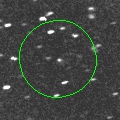
|
Brightening extremely rapidly. Now it is bright as 16.2 mag (June 30, V. Gerke, S. Plaksa). It will be observable at 16 mag in excellent condition in summer.
Date(TT) R.A. (2000) Decl. Delta r Elong. m1 Best Time(A, h)
July 13 15 10.45 -6 47.5 0.976 1.690 116 16.6 19:45 (180, 62)
July 20 15 18.58 -8 50.7 1.012 1.681 112 16.6 19:26 (180, 64)
|
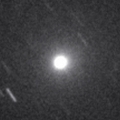
|
Now it is fading. It has already faded down to 16.8 mag (June 30, Hiroshi Abe). It will be unobservable in July in the Northern Hemisphere. It will be fainter than 18 mag in August also in the Southern Hemisphere.
Date(TT) R.A. (2000) Decl. Delta r Elong. m1 Best Time(A, h)
July 13 11 43.79 -8 3.5 2.294 2.154 69 16.8 18:34 (123, 49)
July 20 11 55.89 -9 53.5 2.387 2.183 66 17.1 18:38 (116, 47)
|

|
It has not been observed recently. In the Southern Hemisphere, it keeps observable in good condition for a long time while fading gradually. It is not observable at all in the Northern Hemisphere.
Date(TT) R.A. (2000) Decl. Delta r Elong. m1 Best Time(A, h)
July 13 5 15.53 -41 6.2 5.044 4.796 70 16.8 5:36 (297, 40)
July 20 5 22.04 -41 2.3 5.056 4.830 71 16.9 5:34 (296, 44)
|

|
First return of a new periodic comet discovered in 1998. It is expected to be observable at 15.5 mag in good condition from 2013 autumn to early 2014. However, it has not been recovered yet, although it locates high in the Southern Hemisphere. Actually, it seems to be much fainter than predicted, fainter than 19.5 mag (June 20, Martin Masek).
Date(TT) R.A. (2000) Decl. Delta r Elong. m1 Best Time(A, h)
July 13 1 38.79 -18 23.0 2.764 3.020 94 17.0 5:36 (210, 71)
July 20 1 46.00 -18 39.7 2.659 2.991 99 16.9 5:34 (197, 73)
|

|
First return of a new periodic comet discovered in 2005. It was expected to be observable at 17 mag for a long time from 2013 to 2014. However, it has not been recovered yet. Actually, it is much fainter than predicted, fainter than 20.5 mag (June 8, Danilo Pivato).
Date(TT) R.A. (2000) Decl. Delta r Elong. m1 Best Time(A, h)
July 13 16 42.20 -13 28.7 2.372 3.214 139 17.0 21:16 (180, 69)
July 20 16 40.46 -13 47.1 2.431 3.208 132 17.1 20:47 (180, 69)
|
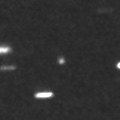
|
Now it is 17.2 mag (June 5, A. C. Gilmore, P. M. Kilmartin). It is expected to brighten up to 7.5 mag and to be observable in excellent condition from summer to autumn in 2014 in the Southern Hemisphere. The condition is bad in the Northern Hemisphere. It will pass extremely close to Mars in 2014 October.
Date(TT) R.A. (2000) Decl. Delta r Elong. m1 Best Time(A, h)
July 13 5 21.81 -15 17.5 6.203 5.582 48 17.1 5:36 (269, 29)
July 20 5 24.83 -15 46.3 6.083 5.519 52 17.0 5:34 (266, 33)
|
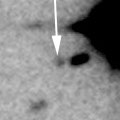
|
Now it is 17.4 mag (June 15, K. Hills). It keeps 17 mag for a long time from 2012 to 2013, and will be observable in good condition in the Southern Hemisphere. It is not observable at all in the Northern Hemisphere.
Date(TT) R.A. (2000) Decl. Delta r Elong. m1 Best Time(A, h)
July 13 2 6.52 -70 9.1 4.594 4.993 107 17.3 5:36 (350, 54)
July 20 1 57.45 -71 39.8 4.573 5.006 109 17.3 5:34 (356, 53)
|

|
It was observed at 15-16 mag in 2012. Now it is fading. It has already faded down to 16.9 mag (June 30, J. F. Soulier). It will be fainter than 18 mag in autumn. It locates low in the Southern Hemisphere.
Date(TT) R.A. (2000) Decl. Delta r Elong. m1 Best Time(A, h)
July 13 2 17.62 38 47.9 4.476 4.190 67 17.4 5:36 (196, 14)
July 20 2 16.68 38 37.2 4.396 4.223 73 17.4 5:34 (190, 15)
|
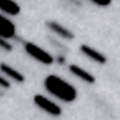
|
It was observed at 18 mag in 2012. It will be observable at 17 mag in excellent condition in 2013.
Date(TT) R.A. (2000) Decl. Delta r Elong. m1 Best Time(A, h)
July 13 0 37.44 16 56.7 4.140 4.350 95 17.5 5:14 (180, 38)
July 20 0 34.57 16 2.6 4.015 4.352 102 17.4 4:44 (180, 39)
|

|
Now it is 17.4 mag (June 29, Jean-Francois Soulier). It has brightened in outburst up to 14 mag twice, in 2006 January and 2011 May. It will pass the perihelion in 2015. It keeps observable at 17 mag for a long time after this.
Date(TT) R.A. (2000) Decl. Delta r Elong. m1 Best Time(A, h)
July 13 19 2.45 -17 53.4 5.558 6.568 172 17.5 23:36 (180, 73)
July 20 18 59.72 -17 59.3 5.562 6.553 166 17.6 23:06 (180, 73)
|
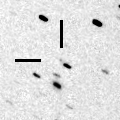
|
Now it is 18.1 mag (June 13, Mt. Lemmon Survey). It is brighter than originally expected by 1 mag. It will brighten up to 16.5 mag and will be observable in good condition from summer to autumn.
Date(TT) R.A. (2000) Decl. Delta r Elong. m1 Best Time(A, h)
July 13 0 27.65 1 17.1 1.513 2.013 103 17.6 5:04 (180, 54)
July 20 0 32.41 3 40.1 1.434 2.002 108 17.5 4:41 (180, 51)
|
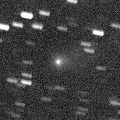
|
It brightened up to 15.5 mag in 2012 summer. Although it has already passed the perihelion, it tends to become brightest after the perihelion passage. Now it is 18.6 mag, fainter than this ephemeris (June 20, A. Maury, J. F. Soulier).
Date(TT) R.A. (2000) Decl. Delta r Elong. m1 Best Time(A, h)
July 13 22 38.81 -19 11.8 2.850 3.647 135 17.5 3:16 (180, 74)
July 20 22 37.07 -19 44.9 2.804 3.664 142 17.5 2:47 (180, 75)
|
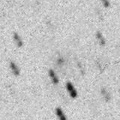
|
Because it is a very distant comet, it will be fading very slowly. It keeps observable at 17.5 mag in 2013.
Date(TT) R.A. (2000) Decl. Delta r Elong. m1 Best Time(A, h)
July 13 23 25.28 11 19.1 9.313 9.759 113 17.7 4:02 (180, 44)
July 20 23 24.89 11 12.7 9.221 9.767 119 17.7 3:34 (180, 44)
|
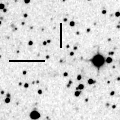
|
Now it is 17.7 mag (June 10, P. Lindner). It is expected to brighten up to 14 mag from 2015 to 2016.
Date(TT) R.A. (2000) Decl. Delta r Elong. m1 Best Time(A, h)
July 13 17 43.08 -2 13.1 7.721 8.597 147 17.8 22:17 (180, 57)
July 20 17 41.18 -2 20.9 7.737 8.562 142 17.8 21:47 (180, 57)
|
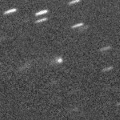
|
It has been observed at 17 mag for a long time from 2009 to 2012. It is also observable at 18 mag in good condition in 2013.
Date(TT) R.A. (2000) Decl. Delta r Elong. m1 Best Time(A, h)
July 13 22 8.95 8 29.5 8.548 9.239 130 17.8 2:46 (180, 46)
July 20 22 5.12 8 19.2 8.488 9.260 137 17.8 2:15 (180, 47)
|

|
It keeps 17 mag for a long time from 2013 summer to early 2015.
Date(TT) R.A. (2000) Decl. Delta r Elong. m1 Best Time(A, h)
July 13 1 47.73 15 25.1 3.342 3.322 80 17.9 5:36 (195, 38)
July 20 1 53.57 15 59.9 3.233 3.308 85 17.8 5:34 (189, 38)
|

|
It was discovered in 1819, and re-discovered in 2003. Although it was predicted to be extremely faint as 26 mag, it unusually brightened up to 17.5 mag in outburst (July 6, Hidetaka Sato). It will pass the perihelion in 2014 August, and will approach to the sun down to 0.96 a.u. The brightness is predicted to be 23 mag at best. However, if the cometary activity continues, it may be observed brighter.
Date(TT) R.A. (2000) Decl. Delta r Elong. m1 Best Time(A, h)
July 13 19 34.64 -27 6.1 2.831 3.844 174 17.9 0:13 (180, 82)
July 20 19 27.56 -27 24.9 2.803 3.809 170 18.1 23:33 (180, 82)
|

|
Now it is 17.4 mag (June 21, Mt. Lemmon Survey). Although it was 16.5 mag in May, it is fading very rapidly after that.
Date(TT) R.A. (2000) Decl. Delta r Elong. m1 Best Time(A, h)
July 13 17 0.06 34 28.4 1.720 2.320 113 17.9 21:33 (180, 20)
July 20 16 46.92 35 46.2 1.821 2.341 107 18.2 20:52 (180, 19)
|
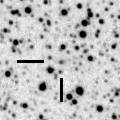
|
It brightened up to 2 mag by unusual major outburst in 2007. It was observed around aphelion at 22 mag. It will return in 2014. It will be 14 mag at best by normal prediction. Now it is 17.2 mag, a bit brighter than this ephemeris (July 3, D. Herald).
Date(TT) R.A. (2000) Decl. Delta r Elong. m1 Best Time(A, h)
July 13 16 59.80 -46 33.1 1.922 2.787 141 17.9 21:34 ( 0, 79)
July 20 16 55.31 -45 32.0 1.940 2.757 135 17.9 21:02 ( 0, 80)
|

|
Now it is 17.4 mag (June 8, Catalina Sky Survey). It keeps 17-18 mag for a long time from 2013 to 2014. It keeps observable in good condition in the Southern Hemisphere. In the Northern Hemisphere, it is only observable until 2013 July.
Date(TT) R.A. (2000) Decl. Delta r Elong. m1 Best Time(A, h)
July 13 14 4.90 -19 7.6 4.716 5.074 104 17.9 18:39 (180, 74)
July 20 14 1.63 -19 34.4 4.815 5.053 97 17.9 18:38 (155, 73)
|
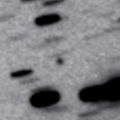
|
It keeps observable at 18 mag for a long time from 2013 to 2016. It keeps locating high in the Northern Hemisphere. It keeps locating very low in the Southern Hemipshere.
Date(TT) R.A. (2000) Decl. Delta r Elong. m1 Best Time(A, h)
July 13 19 28.06 26 18.1 6.288 7.007 131 17.9 0:06 (180, 29)
July 20 19 21.90 26 37.3 6.269 6.989 131 17.9 23:27 (180, 28)
|

|
It was predicted to be 17 mag. But actually, it is much fainter, 19.1 mag (June 30, J. Gonzalez.
Date(TT) R.A. (2000) Decl. Delta r Elong. m1 Best Time(A, h)
July 13 17 54.14 -12 49.2 1.779 2.738 155 18.6 22:28 (180, 68)
July 20 17 50.79 -12 30.9 1.831 2.750 148 18.7 21:57 (180, 67)
|

|
Although it was expected to be bright as 16 mag, actually it was so faint as 19.3 mag, fainter than expected by 3 mag (July 3, Hidetaka Sato). It will be observable in good condition from summer to autumn, however, it will be only 19 mag at best.
Date(TT) R.A. (2000) Decl. Delta r Elong. m1 Best Time(A, h)
July 13 1 48.08 13 0.4 1.144 1.405 80 18.8 5:36 (195, 41)
July 20 2 10.02 15 4.5 1.114 1.397 81 18.7 5:34 (194, 39)
|
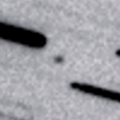
|
It was expected to brighten up to 15 mag in 2013 summer. But actually, it is so faint as 19.5 mag, fainter than expected by 4 mag (July 2, J. F. Soulier).
Date(TT) R.A. (2000) Decl. Delta r Elong. m1 Best Time(A, h)
July 13 22 38.04 22 26.8 1.435 2.093 116 19.1 3:16 (180, 32)
July 20 22 5.01 21 3.7 1.306 2.090 127 19.0 2:16 (180, 34)
|
|
![]()
 C/2011 L4 ( PanSTARRS )
C/2011 L4 ( PanSTARRS ) 26P/Grigg-Skjellerup
26P/Grigg-Skjellerup C/2012 V2 ( LINEAR )
C/2012 V2 ( LINEAR ) C/2012 L2 ( LINEAR )
C/2012 L2 ( LINEAR ) C/2013 N4 ( Borisov )
C/2013 N4 ( Borisov ) C/2012 S1 ( ISON )
C/2012 S1 ( ISON ) 246P/2010 V2 ( NEAT )
246P/2010 V2 ( NEAT ) C/2010 S1 ( LINEAR )
C/2010 S1 ( LINEAR ) C/2006 S3 ( LONEOS )
C/2006 S3 ( LONEOS ) 29P/Schwassmann-Wachmann 1
29P/Schwassmann-Wachmann 1 C/2011 J2 ( LINEAR )
C/2011 J2 ( LINEAR ) (596) Scheila
(596) Scheila C/2012 S3 ( PanSTARRS )
C/2012 S3 ( PanSTARRS ) C/2013 E2 ( Iwamoto )
C/2013 E2 ( Iwamoto ) C/2012 K1 ( PanSTARRS )
C/2012 K1 ( PanSTARRS ) 117P/Helin-Roman-Alu 1
117P/Helin-Roman-Alu 1 C/2013 G5 ( Catalina )
C/2013 G5 ( Catalina ) C/2011 R1 ( McNaught )
C/2011 R1 ( McNaught ) C/2009 F4 ( McNaught )
C/2009 F4 ( McNaught ) C/2012 K6 ( McNaught )
C/2012 K6 ( McNaught ) C/2013 G6 ( Lemmon )
C/2013 G6 ( Lemmon ) 288P/2013 N1 ( Jager )
288P/2013 N1 ( Jager ) C/2011 F1 ( LINEAR )
C/2011 F1 ( LINEAR ) P/2013 J2 ( McNaught )
P/2013 J2 ( McNaught ) 154P/Brewington
154P/Brewington P/2012 F2 ( PanSTARRS )
P/2012 F2 ( PanSTARRS ) P/2012 B1 ( PanSTARRS )
P/2012 B1 ( PanSTARRS ) 257P/2012 F4 ( Catalina )
257P/2012 F4 ( Catalina ) 98P/Takamizawa
98P/Takamizawa 63P/Wild 1
63P/Wild 1 C/2011 O1 ( LINEAR )
C/2011 O1 ( LINEAR ) P/1998 Y2 ( Li )
P/1998 Y2 ( Li ) P/2005 L1 ( McNaught )
P/2005 L1 ( McNaught ) C/2013 A1 ( Siding Spring )
C/2013 A1 ( Siding Spring ) C/2012 C1 ( McNaught )
C/2012 C1 ( McNaught ) C/2012 A2 ( LINEAR )
C/2012 A2 ( LINEAR ) C/2012 S4 ( PanSTARRS )
C/2012 S4 ( PanSTARRS ) 174P/(60558) 2000 EC98 ( Echeclus )
174P/(60558) 2000 EC98 ( Echeclus ) 102P/Shoemaker 1
102P/Shoemaker 1 152P/Helin-Lawrence
152P/Helin-Lawrence C/2012 Q1 ( Kowalski )
C/2012 Q1 ( Kowalski ) C/2011 KP36 ( Spacewatch )
C/2011 KP36 ( Spacewatch ) C/2008 S3 ( Boattini )
C/2008 S3 ( Boattini ) 119P/Parker-Hartley
119P/Parker-Hartley P/1819 W1 ( Blanpain )
P/1819 W1 ( Blanpain ) C/2013 F3 ( McNaught )
C/2013 F3 ( McNaught ) 17P/Holmes
17P/Holmes C/2013 G7 ( McNaught )
C/2013 G7 ( McNaught ) C/2012 K8 ( Lemmon )
C/2012 K8 ( Lemmon ) 91P/Russell 3
91P/Russell 3 184P/Lovas 2
184P/Lovas 2 C/2012 V1 ( PanSTARRS )
C/2012 V1 ( PanSTARRS )![]()













































